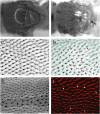The balance between the novel protein target of wingless and the Drosophila Rho-associated kinase pathway regulates planar cell polarity in the Drosophila wing
- PMID: 17409077
- PMCID: PMC1894616
- DOI: 10.1534/genetics.106.069021
The balance between the novel protein target of wingless and the Drosophila Rho-associated kinase pathway regulates planar cell polarity in the Drosophila wing
Abstract
Planar cell polarity (PCP) signaling is mediated by the serpentine receptor Frizzled (Fz) and transduced by Dishevelled (Dsh). Wingless (Wg) signaling utilizes Drosophila Frizzled 2 (DFz2) as a receptor and also requires Dsh for transducing signals to regulate cell proliferation and differentiation in many developmental contexts. Distinct pathways are activated downstream of Dsh in Wg- and Fz-signaling pathways. Recently, a number of genes, which have essential roles as downstream components of PCP signaling, have been identified in Drosophila. They include the small GTPase RhoA/Rho1, its downstream effector Drosophila rho-associated kinase (Drok), and a number of genes such as inturned (in) and fuzzy (fy), whose biochemical functions are unclear. RhoA and Drok provide a link from Fz/Dsh signaling to the modulation of actin cytoskeleton. Here we report the identification of the novel gene target of wingless (tow) by enhancer trap screening. tow expression is negatively regulated by Wg signaling in wing imaginal discs, and the balance between tow and the Drok pathway regulates wing-hair morphogenesis. A loss-of-function mutation in tow does not result in a distinct phenotype. Genetic interaction and gain-of-function studies provide evidence that Tow acts downstream of Fz/Dsh and plays a role in restricting the number of hairs that wing cells form.
Figures







Similar articles
-
Drosophila Rho-associated kinase (Drok) links Frizzled-mediated planar cell polarity signaling to the actin cytoskeleton.Cell. 2001 Apr 6;105(1):81-91. doi: 10.1016/s0092-8674(01)00298-7. Cell. 2001. PMID: 11301004
-
CKIepsilon/discs overgrown promotes both Wnt-Fz/beta-catenin and Fz/PCP signaling in Drosophila.Curr Biol. 2006 Jul 11;16(13):1337-43. doi: 10.1016/j.cub.2006.06.030. Curr Biol. 2006. PMID: 16824922
-
The Drosophila STE20-like kinase misshapen is required downstream of the Frizzled receptor in planar polarity signaling.EMBO J. 1999 Sep 1;18(17):4669-78. doi: 10.1093/emboj/18.17.4669. EMBO J. 1999. PMID: 10469646 Free PMC article.
-
Planar polarity from flies to vertebrates.J Cell Sci. 2004 Feb 1;117(Pt 4):527-33. doi: 10.1242/jcs.00973. J Cell Sci. 2004. PMID: 14730010 Review.
-
Coupling planar cell polarity signaling to morphogenesis.ScientificWorldJournal. 2002 Feb 15;2:434-54. doi: 10.1100/tsw.2002.105. ScientificWorldJournal. 2002. PMID: 12806028 Free PMC article. Review.
Cited by
-
Serrano (sano) functions with the planar cell polarity genes to control tracheal tube length.PLoS Genet. 2009 Nov;5(11):e1000746. doi: 10.1371/journal.pgen.1000746. Epub 2009 Nov 26. PLoS Genet. 2009. PMID: 19956736 Free PMC article.
-
Hedgehog signaling and gastrointestinal cancer.Biochim Biophys Acta. 2010 Jul;1803(7):786-95. doi: 10.1016/j.bbamcr.2010.03.008. Epub 2010 Mar 19. Biochim Biophys Acta. 2010. PMID: 20307590 Free PMC article. Review.
-
Characterizing dopaminergic neuron vulnerability using genome-wide analysis.Genetics. 2021 Aug 9;218(4):iyab081. doi: 10.1093/genetics/iyab081. Genetics. 2021. PMID: 34038543 Free PMC article.
-
Nephronophthisis-Pathobiology and Molecular Pathogenesis of a Rare Kidney Genetic Disease.Genes (Basel). 2021 Nov 5;12(11):1762. doi: 10.3390/genes12111762. Genes (Basel). 2021. PMID: 34828368 Free PMC article. Review.
-
Overexpression of CTHRC1 in hepatocellular carcinoma promotes tumor invasion and predicts poor prognosis.PLoS One. 2013 Jul 29;8(7):e70324. doi: 10.1371/journal.pone.0070324. Print 2013. PLoS One. 2013. PMID: 23922981 Free PMC article.
References
-
- Adler, P. N., 2002. Planar signaling and morphogenesis in Drosophila. Dev. Cell 2 525–535. - PubMed
-
- Adler, P. N., and H. Lee, 2001. Frizzled signaling and cell–cell interactions in planar polarity. Curr. Opin. Cell Biol. 13 635–640. - PubMed
-
- Adler, P. N., J. Taylor and J. Charlton, 2000. The domineering non-aunotomy of frizzled and Van Gogh clones in the Drosophila wing is a consequence of disruption in local signaling. Mech. Dev. 96 197–207. - PubMed
-
- Bhanot, P., M. Brink, C. Harryman Samos, J.-C. Hsieh, Y. Wang et al., 1996. A new member of the frizzled family from Drosophila functions as a Wingless receptor. Nature 382 225–230. - PubMed
Publication types
MeSH terms
Substances
Grants and funding
LinkOut - more resources
Full Text Sources
Molecular Biology Databases

